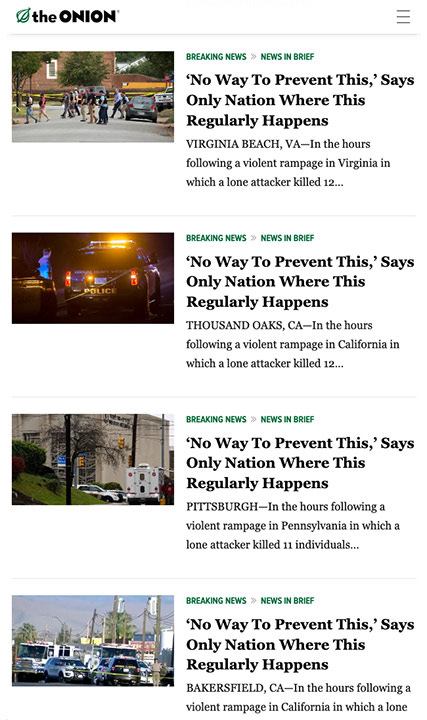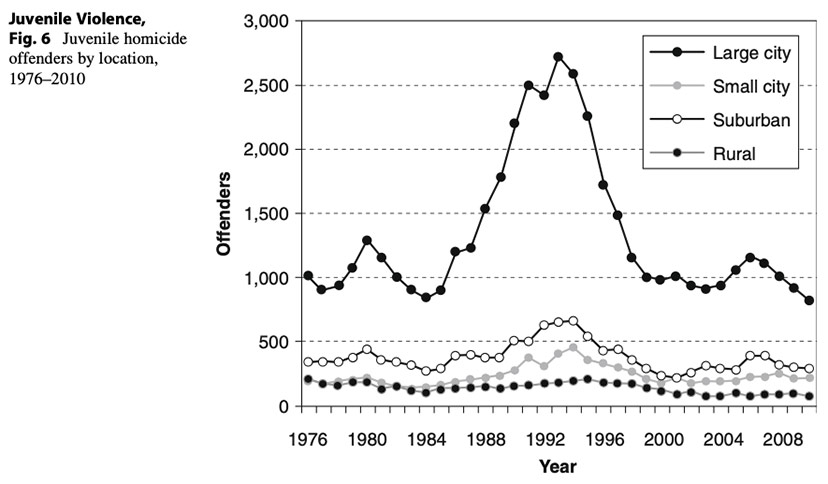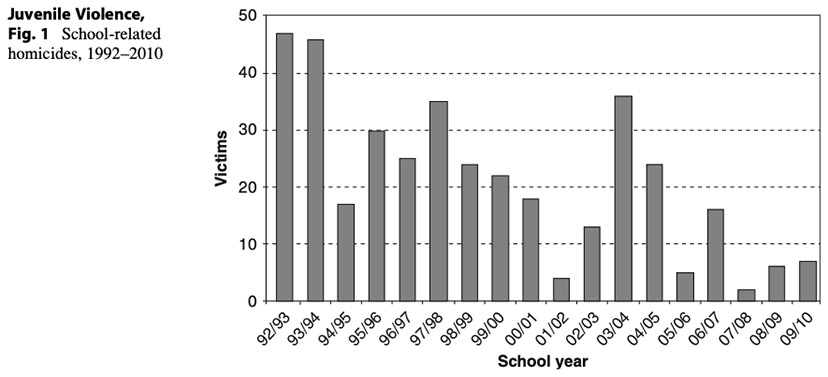Since 2014, the satirical website The Onion has responded to news of mass shootings by deploying the same darkly sarcastic headline and story, with only the location updated to reflect the most recent shooting event:
‘No Way To Prevent This,’ Says Only Nation Where This Regularly Happens
In the hours following a violent rampage in Texas in which a lone attacker killed at least 21 individuals and injured several others, citizens living in the only country where this kind of mass killing routinely occurs reportedly concluded Tuesday that there was no way to prevent the massacre from taking place.
“This was a terrible tragedy, but sometimes these things just happen and there’s nothing anyone can do to stop them,” said Idaho resident Kathy Miller, echoing sentiments expressed by tens of millions of individuals who reside in a nation where over half of the world’s deadliest mass shootings have occurred in the past 50 years and whose citizens are 20 times more likely to die of gun violence than those of other developed nations.
“It’s a shame, but what can we do? There really wasn’t anything that was going to keep this individual from snapping and killing a lot of people if that’s what they really wanted.”
At press time, residents of the only economically advanced nation in the world where roughly two mass shootings have occurred every month for the past eight years were referring to themselves and their situation as “helpless.”

The tragedies that involve children are especially inexplicable. But at The Onion suggests, we can easily feel ‘helpless’.
We can also feel that we absolutely must do something to prevent these calamities, especially in schools.
More police protection in the hallways? More ‘active shooter drills’?
One of the Daily Post’s past contributors, psychologist Ana Sancho Sama, PhD, wrote a two-part op-ed back in 2020, on the subject of the ‘active shooter drills’ being conducted in American schools. Her research, which you can read here, was compelling, arguing that ‘active shooter drills’ caused unnecessary psychological trauma, without offering significant, measurable benefits.
I can’t say whether her article influenced the community leaders who oversee our local schools.
We are all deeply disturbed — and also confused — by the apparently senseless gun violence that gets reported in the media. When a young man enters an elementary school and murders teachers and children with whom he has no apparent relationship, we can’t understand what’s happening, or why.
We’re able to better understand hate-driven violence. Violence caused by hate and racial prejudice have a long, and well-documented, history in America. Ditto, political violence. Ditto, criminal and gang violence.
Random violence is so much harder to wrap our heads around.

In her 2020 op-ed, Dr. Sancho Sama cited some possible explanations for apparently senseless violence, and offered this summary of relevant factors:
1. The majority of school shootings have been perpetrated by males, and over 90% were active or recent students at the school. This also speaks about the students’ knowledge of the drills’ operations and thus, what to do to disable certain lockdown measures.
2. A predominant theme in the school shootings is anger and revenge: 75% of school shooters felt bullied or harassed by other students, sometimes felt unfairly treated by teachers, and seldom had specific targets other than to kill randomly to inflict the most harm.
3. School shooters tend to be socially awkward and avoidant, and often isolate with a few (if any) friends. Thus, there are antisocial tendencies present, such as detailed planning, fascination with violence, the macabre, or death; some had histories of cruelty to animals, and may have had a history of adverse encounters with law enforcement.
4. The “media contagion effect” or copycat effect, may serve as an especially powerful motivator for those who already feel anger, frustration or loss.
5. Shooters tend to have experienced dysfunctional family situations, such as lack of effective adult supervision, mentoring or oversight.
6. Sixty-eight percent of shooters obtained weapons from their home or the home of a relative. (Yes, ease of availability to firearms does matter.)
7. Shooters tend to express their frustrations and anger using art or social media posts; thus, monitoring of such media becomes an important tool in early identification of individuals at risk for committing violence.
America, as a whole, has seen a sharp decline in violent crime since the mid-1990s. Juvenile violence, in particular, has decreased significantly. Here, for example, is a graph showing the change in homicides committed by juveniles between 1978 and 2008. Shown are all homicides, both inside and outside of schools. The vast majority occurred outside of school, out in the larger community.

We will note the stark difference been the homicide rate in large cities, compared to rural communities — a 10-fold difference during the early 1990s. We’ll touch on that discrepancy later.
The graph comes from a 2014 analysis by James Alan Fox, Michael Rocque and Chad Posick, conducted by Northeastern University School of Criminal Justice. You can download the report here.
The authors write:
In the mid- to late 1990s, America was seemingly faced with a frightening epidemic: senseless acts of large-scale violence taking place in ostensibly safe, middle-class schools. Multiple instances of rampage-style shootings occurred in suburban and rural locales across the nation, the most deadly of which was the April 20, 1999 massacre at Columbine High School. Schools no longer felt safe.
However, despite several isolated cases of school shootings involving multiple (oftentimes random) victims, schools WERE safe. In fact, by the late 1990s, school-related homicides were on the decline – a trend that has continued to the present. Thus, notwithstanding the seriousness of the rampage school shootings of the late 1990s, defining the problem as an epidemic was a hyperbolic overreach.
The following graph from the same article displays school-related homicides since the early 1990s, through 2010. As shown, the actual count of school homicide victims had been declining since the mid-1990s.

Since that graph was created in 2014, we’ve heard about 27 people killed at Sandy Hook Elementary School in Newtown, Connecticut; 17 people killed at Marjory Stoneman Douglas High School in Parkland, Florida; 10 people killed at Santa Fe High School in Santa Fe, Texas; and 22 people killed at Robb Elementary School in Uvalde, Texas. Literally hundreds of less-deadly school shootings have taken place in America since 2000. You can view a list here.
Some shootings appear to have a motive, as chilling as it might be. Other shootings seem random, and senseless.
All of them have something in common. They sell newspapers.
